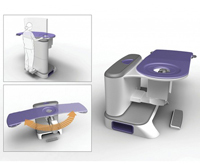With her graduate thesis project, University of Notre Dame alumna Charlotte Lux M.F.A. ’11 set out to redesign a stressful diagnostic procedure women who might have breast cancer undergo in the hopes of making it less traumatic.
The resulting design has earned Lux recognition in the 2012 Core77 Design Awards, where she was named student winner in the strategy and research category. Core77 is an influential industrial design magazine and resource that has been operating since 1995.
Lorraine Justice, jury captain for the award category and dean of College of Imaging Arts and Sciences at Rochester Institute of Technology, called Lux’s project both thoughtful and well researched, noting that “it takes into consideration the physical and mental comfort of the patient while allowing the medical personnel to do their job.”
“Student work conducted at this level is inspirational,” adds Don Carr, another Core77 jurist and a design professor at Syracuse University. “I hope these findings will impact the field.”
Observation and Insight

Lux, whose family health history includes breast cancer, says she drew heavily on ethnographic research funded by Notre Dame’s Institute for Scholarship in the Liberal Arts to develop her approach to stereotactic breast biopsies (SBB), a type of assessment doctors use to follow up on abnormal mammogram results.
When being tested with this procedure, a patient must remain perfectly still for up to an hour, while her breast is placed in compression paddles and a suspicious area is isolated, x-rayed, and sampled with a large core needle.
To figure out how to reduce the trauma of this procedure, Lux observed 12 biopsies and got input from six radiologists, five facility administrators, three nurses, 11 x-ray techs, and 16 biopsy patients across seven facilities in Illinois, Indiana, Ohio, and California.
To analyze the procedure from all relevant perspectives, she also looked at SBB in a broader context of what patients go through on the way to a potential breast cancer diagnosis: “Everything from patient consultations and screening mammograms—which I underwent myself, documented, and analyzed as an immersive exercise—to ultrasounds and a variety of biopsy procedure types,” she says.
Lux believes her work could give equipment manufacturers and the hospitals and labs they serve the opportunity to improve both efficiency and patient comfort.
The design also aims to empower patients, she adds. “The tactical goal of my research and design effort shifted from figuring out how to make the patient comfortable to actually empowering the patient to play an active role in the delivery of her care.”
Throughout the SBB procedure, Lux says, the patient is awake and must work with clinicians to remain still and calm enough to avoid being caught off guard when the needle is inserted. To help in this challenging task, the redesign encompasses what Lux calls the key “touch points” in the diagnostic procedure: the nurse-patient information exchange, the gown a patient wears, visual focal points in the test room, and the table on which patients are prone throughout most of the procedure.
“This work represents the potential of Design—with a capital D—to contribute to the discovery and materialization of innovative solutions to problems in the delivery of healthcare,” Lux says.
Design for Good
“Charlotte was an extraordinary graduate student who arrived on campus with significant professional experience and a want to readjust her career path,” recalls Robert Sedlack ’89, associate professor of graphic design and director of graduate studies in the Department of Art, History and Design.
“Her first two years of our three-year program were so successful,” he says, “she was offered a job during the fall of her final year at Notre Dame—and the company, IA Collaborative, held the position for her until she graduated.
Her desire not just to advance her career but also to make a difference in people’s lives is a critical part of her success in school and as a professional, Sedlack continues.
“She came to Notre Dame because she was interested in our program’s emphasis on design for social good.”
Learn More >
- Department of Art, History and Design
- Related story on Lux’s SBB project
- Graduate Student Research Awards
- 2012 Core77 Design Awards
- Core77 feature on Lux’s winning design
Originally published by at al.nd.edu on August 14, 2012.

